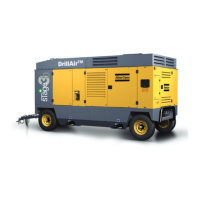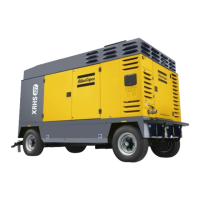Do you have a question about the Atlas Copco XRVS 1000 CD7 IT4 HOP and is the answer not in the manual?
Overview of the importance and purpose of safety guidelines.
Lists fundamental safety rules for operating the compressor.
Safety measures for moving and setting up the compressor.
Safety instructions for running the compressor under various conditions.
Safety procedures during maintenance, repair, and servicing.
Safe use of tools and precautions when handling batteries.
Specific safety rules and precautions related to battery handling.
Procedures for testing, maintenance, and safety of safety valves.
Overview of the XRVS 1000 model and its primary features.
Details on the engine, compressor, oil, and cooling systems.
Information on safety features and the compressor's control panel.
Describes the unit's physical structure, chassis, bodywork, and exhaust system.
Explains the EGR system for reducing NOx emissions.
Describes the Diesel Particulate Filter and DOC for emission control.
Details the process of burning off particulate matter in the filter.
Explains the need for mechanical removal of ash from the filter.
Guidelines for safely parking, towing, and lifting the compressor unit.
Safety rules related to power, battery switch, and fuel.
Explains the main controls and indicators on the unit's panel.
Describes the function of each button on the control panel.
Explains icons shown in the main display view.
Describes icons for measurements, settings, and alarms.
Details icons for operating modes and fuel tank status.
Explains how to navigate between different display views.
Describes accessing alarm logs and using navigation buttons.
Steps for powering up the controller and system selftest.
Procedures for checking and preparing the vessel pressure for starting.
Process of powering the ECU and engine preheating.
Describes the engine cranking and warming up phases.
Indicates when the machine is ready for loading and pressure building.
Describes loading preparation and routine operational checks.
Describes the engine cooling down sequence after a stop command.
Steps for safely shutting down and powering off the unit.
Explanation of the DPF regeneration process and its automatic operation.
Details on the default automatic DPF regeneration process.
How to disable DPF regeneration when needed.
Explains warnings related to high soot load and DPF regeneration needs.
Procedure to manually initiate DPF regeneration when required.
How to acknowledge active alarms on the control panel.
Procedures for configuring date, time, units, and language.
How to adjust display backlight and other visual parameters.
Information on manufacturer liability, service packs, and service kits.
Guidelines for storing the unit and essential safety precautions for maintenance.
Details on recommended synthetic and mineral compressor oils.
Detailed steps for changing compressor oil and filters.
Information on PARCOOL EG coolant, its properties, and benefits.
Guidelines for handling, checking, and maintaining PARCOOL EG coolant.
Instructions for handling electrolyte and activating dry-charged batteries.
Procedures for battery recharging, topping up water, and periodic service.
Maintenance and replacement procedures for air filters.
Steps for replacing filter elements and safety cartridges.
Inspection of the air receiver and safety valve checks.
Procedures for priming the fuel system and key-on priming.
Steps for replacing fuel filter elements.
How to clean the crankcase breather filter.
Inspecting the rubber torsion suspension system for wear.
Procedures for inspecting brake drums, bearings, and lubrication.
Guidelines for inspecting and replacing seals in wheel bearings.
Troubleshooting steps for low capacity or pressure problems.
Solutions for high receiver pressure causing safety valve blow.
Troubleshooting for unit shutdown due to engine or coolant issues.
Addressing air and oil mist expelled from filters after stopping.
Causes and solutions for compressor overheating issues.
Important precautions related to the alternator and battery connections.
Procedure for manually locking the Oiltronix valve as a temporary fix.
Options for mounting and integrating larger fuel tanks.
Description of the inlet shutdown valve safety device.
Features for easy movement using a forklift.
Recommended torque values for assembly and critical components.
Standard conditions for compressor performance data.
Operating limits including pressure, temperature, and altitude.
Technical details of the compressor stages and build.
Specifications for the Caterpillar C13 IT4 engine.
Information on oil, air receiver, and fuel tank capacities.
Dimensions and weight of the compressor unit.
Atlas Copco's policy on minimizing environmental impact and recycling.
Procedures for properly disposing of contaminated substances and components.
Overview of the importance and purpose of safety guidelines.
Lists fundamental safety rules for operating the compressor.
Safety measures for moving and setting up the compressor.
Safety instructions for running the compressor under various conditions.
Safety procedures during maintenance, repair, and servicing.
Safe use of tools and precautions when handling batteries.
Specific safety rules and precautions related to battery handling.
Procedures for testing, maintenance, and safety of safety valves.
Overview of the XRVS 1000 model and its primary features.
Details on the engine, compressor, oil, and cooling systems.
Information on safety features and the compressor's control panel.
Describes the unit's physical structure, chassis, bodywork, and exhaust system.
Explains the EGR system for reducing NOx emissions.
Describes the Diesel Particulate Filter and DOC for emission control.
Details the process of burning off particulate matter in the filter.
Explains the need for mechanical removal of ash from the filter.
Guidelines for safely parking, towing, and lifting the compressor unit.
Safety rules related to power, battery switch, and fuel.
Explains the main controls and indicators on the unit's panel.
Describes the function of each button on the control panel.
Explains icons shown in the main display view.
Describes icons for measurements, settings, and alarms.
Details icons for operating modes and fuel tank status.
Explains how to navigate between different display views.
Describes accessing alarm logs and using navigation buttons.
Steps for powering up the controller and system selftest.
Procedures for checking and preparing the vessel pressure for starting.
Process of powering the ECU and engine preheating.
Describes the engine cranking and warming up phases.
Indicates when the machine is ready for loading and pressure building.
Describes loading preparation and routine operational checks.
Describes the engine cooling down sequence after a stop command.
Steps for safely shutting down and powering off the unit.
Explanation of the DPF regeneration process and its automatic operation.
Details on the default automatic DPF regeneration process.
How to disable DPF regeneration when needed.
Explains warnings related to high soot load and DPF regeneration needs.
Procedure to manually initiate DPF regeneration when required.
How to acknowledge active alarms on the control panel.
Procedures for configuring date, time, units, and language.
How to adjust display backlight and other visual parameters.
Information on manufacturer liability, service packs, and service kits.
Guidelines for storing the unit and essential safety precautions for maintenance.
Details on recommended synthetic and mineral compressor oils.
Detailed steps for changing compressor oil and filters.
Information on PARCOOL EG coolant, its properties, and benefits.
Guidelines for handling, checking, and maintaining PARCOOL EG coolant.
Instructions for handling electrolyte and activating dry-charged batteries.
Procedures for battery recharging, topping up water, and periodic service.
Maintenance and replacement procedures for air filters.
Steps for replacing filter elements and safety cartridges.
Inspection of the air receiver and safety valve checks.
Procedures for priming the fuel system and key-on priming.
Steps for replacing fuel filter elements.
How to clean the crankcase breather filter.
Inspecting the rubber torsion suspension system for wear.
Procedures for inspecting brake drums, bearings, and lubrication.
Guidelines for inspecting and replacing seals in wheel bearings.
Troubleshooting steps for low capacity or pressure problems.
Solutions for high receiver pressure causing safety valve blow.
Troubleshooting for unit shutdown due to engine or coolant issues.
Addressing air and oil mist expelled from filters after stopping.
Causes and solutions for compressor overheating issues.
Important precautions related to the alternator and battery connections.
Procedure for manually locking the Oiltronix valve as a temporary fix.
Options for mounting and integrating larger fuel tanks.
Description of the inlet shutdown valve safety device.
Features for easy movement using a forklift.
Recommended torque values for assembly and critical components.
Standard conditions for compressor performance data.
Operating limits including pressure, temperature, and altitude.
Technical details of the compressor stages and build.
Specifications for the Caterpillar C13 IT4 engine.
Information on oil, air receiver, and fuel tank capacities.
Dimensions and weight of the compressor unit.
Atlas Copco's policy on minimizing environmental impact and recycling.
Procedures for properly disposing of contaminated substances and components.
| Model | XRVS 1000 CD7 IT4 HOP |
|---|---|
| Type | Rotary Screw Compressor |
| Free Air Delivery | 1000 cfm |
| Emissions | Tier 4 Interim |
| Drive Type | Direct Drive |
| Working Pressure | 100 psi |
| Noise Level | 76 dB(A) |
| Cooling Method | Air Cooled |
| Voltage | Not applicable |
| Frequency | Not applicable |











